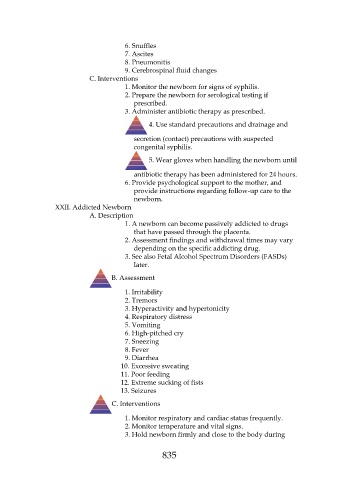Page 835 - Saunders Comprehensive Review For NCLEX-RN
P. 835
6. Snuffles
7. Ascites
8. Pneumonitis
9. Cerebrospinal fluid changes
C. Interventions
1. Monitor the newborn for signs of syphilis.
2. Prepare the newborn for serological testing if
prescribed.
3. Administer antibiotic therapy as prescribed.
4. Use standard precautions and drainage and
secretion (contact) precautions with suspected
congenital syphilis.
5. Wear gloves when handling the newborn until
antibiotic therapy has been administered for 24 hours.
6. Provide psychological support to the mother, and
provide instructions regarding follow-up care to the
newborn.
XXII. Addicted Newborn
A. Description
1. A newborn can become passively addicted to drugs
that have passed through the placenta.
2. Assessment findings and withdrawal times may vary
depending on the specific addicting drug.
3. See also Fetal Alcohol Spectrum Disorders (FASDs)
later.
B. Assessment
1. Irritability
2. Tremors
3. Hyperactivity and hypertonicity
4. Respiratory distress
5. Vomiting
6. High-pitched cry
7. Sneezing
8. Fever
9. Diarrhea
10. Excessive sweating
11. Poor feeding
12. Extreme sucking of fists
13. Seizures
C. Interventions
1. Monitor respiratory and cardiac status frequently.
2. Monitor temperature and vital signs.
3. Hold newborn firmly and close to the body during
835

